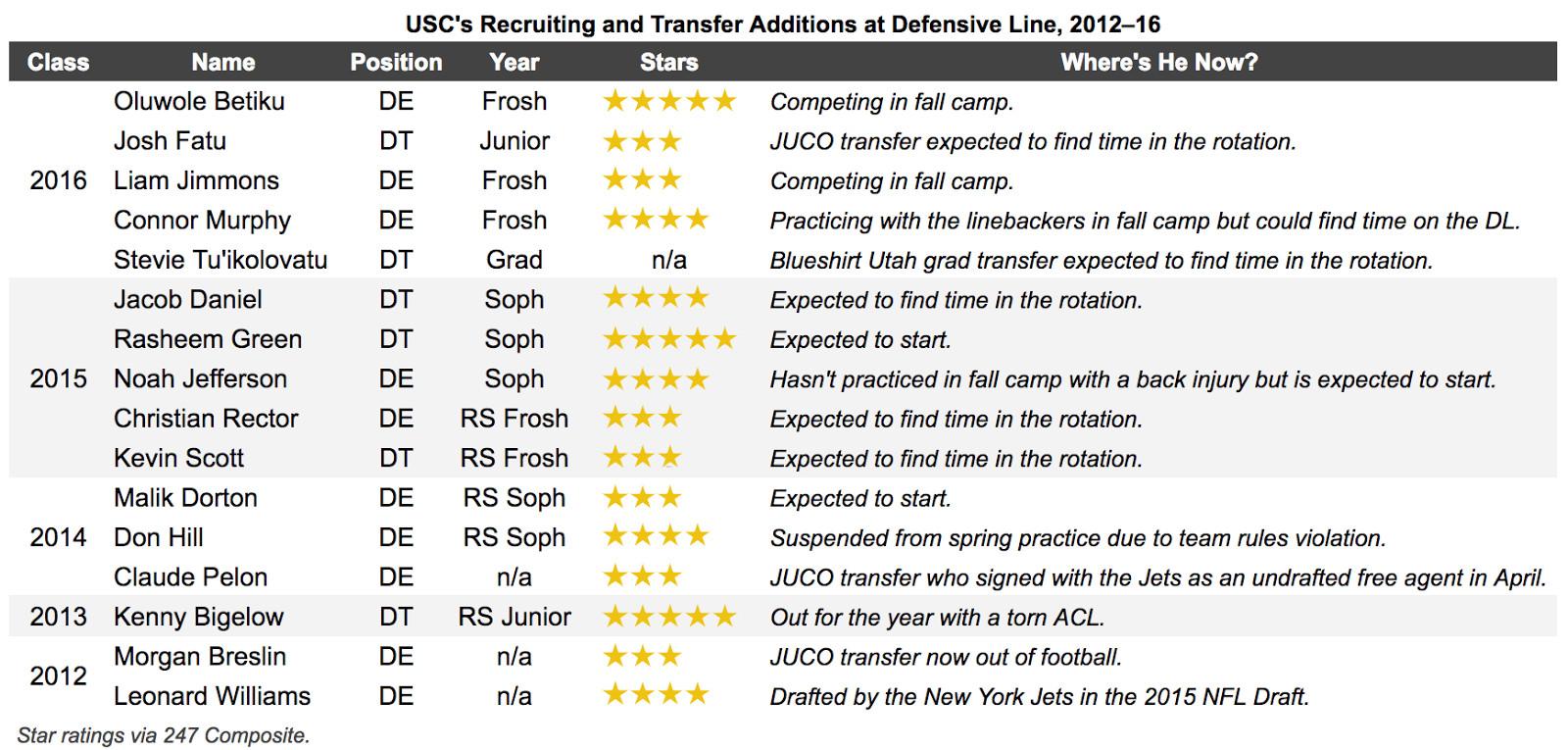College football fans know that nothing in the sport lasts. Roster turnover is constant, with no player having more than four years of NCAA eligibility. Unlike in the pro game, a down period at the college level doesn’t have to drag on for a generation (or longer). There are still dynasties and dumpster fires, but just one great coach, blue-chip recruiting class, or transformative player can launch a program into the upper echelon of the sport (hi, Baylor!), while setbacks can quickly send it into the abyss (hi again, Baylor). A team is never more than a few years removed from glory or disaster.
While time can rapidly change a team’s outlook for the future, it can’t rewrite the past. USC has discovered this firsthand, and not just because of one bad recruiting class. The Trojans are still haunted by the shadow of transgressions that occurred more than a decade ago.
Though the sanctions that stemmed from Reggie Bush’s controversial NCAA infractions technically abated in 2015, concluding USC’s two-year bowl ban (in 2010 and 2011) and crippling scholarship limits (2012–14), the damage still lingers. This year’s team has an astonishing amount of talent and the top national-championship odds of any Pac-12 squad, but the ramifications of those scholarship reductions are hampering this year’s defensive line. On an otherwise loaded roster, that unit’s frightening lack of experience and depth is the kind of blemish that could keep the team from competing for a Pac-12 championship … again.

Even factoring in the restrictions, which limited USC to 15 new scholarships per year instead of the usual 25, USC remained USC. The Trojans were still able to nab some of the best athletes in the country on an annual basis, ranking second nationally in recruiting over the last five years despite sanctions. As Utah coach Kyle Whittingham quipped at last year’s Pac-12 media days, “Instead of 85 five-star guys, they’ve got 65.”
They aren’t all five-star guys, of course, but they are talented. Though the quarterback competition is still underway, Max Browne had two years to learn behind Cody Kessler and is a former no. 1 pro-style prospect. JuJu Smith-Schuster, a first-team all-conference selection last year, looks like the best receiver in the Pac-12, and possibly the nation. Linebacker Cameron Smith, who led the team in tackles and interceptions through 10 games as a true freshman before a knee injury cut his 2015 campaign short, has looked healthy in camp. Meanwhile, Adoree’ Jackson, USC’s do-it-all corner and almost-Olympian who doubles as a wide receiver and triples as a return specialist, could rival Jabrill Peppers for the title of college football’s most versatile player.
In Phil Steele’s annual college football preview, USC’s position groups rank among the nation’s best, with the running backs checking in eighth; receivers fourth; offensive line first; linebackers 19th; and secondary seventh. But the defensive line checks in at a middling 42nd.
The talent deficit on the 2016 defensive line has been years in the making, tracing back to the 2012–2013 stretch in which the Trojans landed just 29 recruits total — and only three of them defensive linemen.

The glut of linemen the team has attracted since 2015 spells a brighter future for the unit, but that doesn’t necessarily fix its present problems. Under normal circumstances, USC would have had a few eligible redshirt seniors recruited in 2012 to stick on the line, but with just two guys in that class, that wasn’t possible — Leonard Williams was talented enough to leave for the NFL after his junior season and Morgan Breslin, a junior college transfer, saw his eligibility run out after 2013. Kenny Bigelow, USC’s only D-line recruit in 2013, looked to be the lone veteran presence on the line this season until he tore his ACL in March, his second season-ending knee injury as a Trojan.
The 2014 class has similarly been a disaster: Though Malik Dorton has earned time as a starter in fall camp, he’s switched positions twice while at USC (from outside linebacker to defensive end to defensive tackle) and has only played in two games his entire career. Claude Pelon was a community college transfer — he’s long gone. Don Hill was suspended due to a team-rules violation in the spring; how much he’ll contribute is up in the air.
The result is a defensive line void of any veteran leadership whatsoever; USC will have to rely almost exclusively on sophomores and freshmen for its needs up front.
How did it get so dire? A combination of bad luck and bad vibes. That’s not really the program’s fault — the realities of the NCAA’s sanctions meant the Trojans were bound to find holes in their roster’s construction somewhere. A series of decommitments seemingly related to the general turmoil surrounding the team hit the defensive line the hardest. Five-star recruit Eddie Vanderdoes decommitted in December 2012 and ultimately ended up with rival UCLA. After an injury kept him out last season, Vanderdoes elected to return to the Bruins this year, where he will head their line. Four-star prospect Torrodney Prevot said he was “99 percent” sure he’d join the Trojans … until he decommitted on signing day, saying later that he felt the coaching staff wasn’t stable; he’s projected to start for Oregon at defensive end this season. Four-star prospect Jason Hatcher committed and decommitted to USC (twice!) before heading to Kentucky, where he was dismissed earlier this year after a marijuana-trafficking charge; he will play for Division II West Georgia this fall. USC literally didn’t have a scholarship to offer blue-chipper Kylie Fitts, who was ultimately forced to leave his “dream school” for UCLA. After a transfer, Fitts started for Utah in 2015 and is expected to do so again this year.
The school’s litany of missed connections during its dark age of recruitment has culminated with what we’ll be seeing this year. The trio of likely starters up front — sophomores Rasheem Green, Noah Jefferson, and Dorton — has combined for one (!) start between them. Behind those three is a rotation of freshmen with little to no experience and a grad transfer who started two games for Utah last year (but who has impressed in camp).
“Biggest worry is probably the thinness a little bit at defensive line,” coach Clay Helton admitted at this year’s Pac-12 media days. “We’re going to be a little thin there, a little bit inexperienced. … It doesn’t mean that they’re not talented, they’re just inexperienced.”

The man tasked with putting this line together is new defensive coordinator Clancy Pendergast. He’s done it before: Pendergast put together solid defenses at Cal from 2010 through 2012, and he helmed the Trojans defense in 2013, when the unit ranked 4th in the country in defensive S&P+. (The unit regressed sharply once Steve Sarkisian put Justin Wilcox in charge the following year.)
Players reportedly love to work with Pendergast, and all of the players on the 2016 line are highly touted recruits. The much-hyped Green, in particular, who combines a 6-foot-5, 280-pound frame with the ability to burst into the backfield, has the look of a future star.
Pendergast runs a 5–2 defense, which isn’t too dissimilar from the 3–4 USC ran last year — both feature three down linemen, though the 5–2 is more aggressive at the line of scrimmage. It should give players like Porter Gustin and Jabari Ruffin, outside linebackers in last year’s scheme, more time in a hybrid role that will allow them to function like defensive ends. Though they’ll stand up on the edges of the line, they’ll rarely drop back into coverage, focusing instead on rushing the passer. That especially benefits Gustin, who played in all 14 games as a freshman and racked up 5.5 sacks. Both players have been reclassified as defensive ends on the roster.
“We’ll do things as coaches to be able to help us help a young [defensive] line,” Helton said at media days. “Load the box, there’s going to be more pressure put on our defensive backs to play some man coverage and to help a defensive line whether it’s pressures or dropping a safety in the box, whatever it might be, we’ll do those things to help them.”
Behind talents like Adoree’ Jackson and Iman Marshall, USC’s secondary should be able to hold its own when teams stack the box, but no matter how the team arranges the front seven, there’s no disguising how many underclassmen the Trojans are relying on up front.
Though it’s possible that Pendergast will be able to put together a solid total defense, the team’s schedule, which includes dates with Stanford, Oregon, Washington, UCLA, Notre Dame, and freaking Alabama, won’t be forgiving. It’s easy to see how the Crimson Tide could run roughshod over the Trojans in Week 1 (ditto for the Cardinal and all-everything running back Christian McCaffrey two weeks later).
The Trojans are ready to reload, but their defensive line will be a continued reminder of how the 2010 sanctions have taken their toll; it’s the phantom limb still threatening the school’s renewed championship aspirations. If the 2016 Trojans can’t defend the run, we’ll know exactly why.
